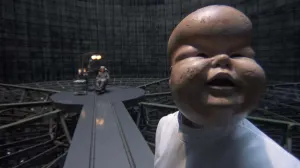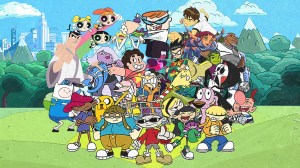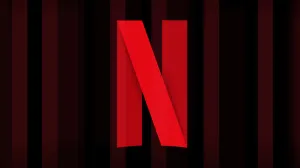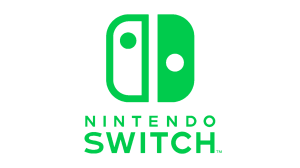Back in 2016, Arrow star Stephen Amell and his cousin, The Flash star Robbie Amell debuted Code 8, a short film set in a world that saw 4 percent of the population having superpowers, but also treated like outcasts as a result. The short film, which followed Robbie’s character simply attempting to earn a living and survive in this brutal, oppressive world, quickly earned a lot of excitement from fans. Soon after the short film’s release, the actors turned their attention to expanding on that short film and launched a crowdfunding campaign to make Code 8 a full-length feature. Three years later, those efforts have paid off. Code 8 is set to hit theaters and on-demand in just two weeks.
Videos by ComicBook.com
But how do you go from an established short film to the full-length feature? What goes into effectively rebuilding a world fans first got a glimpse of three years before and, then, expanding on it? How do you create a world that’s like our own while also being totally unique and different at the same time? All of these are questions and challenges faced by Chris Crane, the production designer for Code 8. ComicBook.com recently had the opportunity to sit down with Crane to talk about how the world of Code 8 came together and what it was like to jump into a project that already had a somewhat established world and then take it to the next level — including sourcing some interesting locations for some of the film’s most significant settings and the work of making the fictional Lincoln City its own, unique space.
Keep on reading to find out more about the creation and world-building of Code 8!
On becoming involved with the Code 8 feature film and building off of the short
ComicBook.com: How did you get involved with Code 8?
Chris Crane: Weirdly, I met with Jeff Chan, the director, a few years ago, four years ago now. He was doing a short film version of it. But what happened was the short ended up going to LA to shoot, so I wasn’t part of that. And then when they brought the feature to Toronto, I was just one of the people interviewed. And I was like, “Hey, I remember you. I remember this project.” And then we just clicked. I really liked the script, put together a package. Yeah, and then I got the job.
ComicBook.com: Like you said, the short did film out in LA, and that’s been a few years ago. So when you came on to do the feature, having that world already established, can you tell me a little bit about how you went into the feature knowing that there had been a world that’s already been established. It’s been a little while, some people are going to come into this new. How did you go about creating this alternate reality that’s like our own but also very different?
Chris Crane: Well, one thing Jeff always said was it’s more of a “five seconds in the future” kind of place. So we never went to… I guess by five it’s always like, “What’s the tech now, and what’s on the cusp of being really popular?” And then just kind of leaning into that. For me, the short was a few really great scenes that were kind of put together, and I was able to expand more on that in the future. So that was a really good experience, to be able to take what was [inaudible] and kind of have a base from the short and kind of expand on that information.
On creating the film’s near-future setting
ComicBook.com: When you stay it’s five seconds in the future, you absolutely see that in the film. The vehicles, the buildings, people’s behaviors. It look very much like our world, but clearly enhanced a little bit because our history’s been a little bit different. When you went to create that, what things did you have to take into consideration about the plot of the story? Because in the story, 4% of the human population is special, and that’s been a thing for a while. How did you have to take that into consideration into how you developed that look and how it might’ve impacted technology?
Chris Crane: Well, one thing I liked, this short really focused more on Connor’s life, his perspective, and he would be lower income, was struggling a bit in this world. I liked that having a power didn’t make you more special in a way, it was actually a negative. It meant you had to overcome some more obstacles than people that maybe didn’t have that.
And so, once I got the script and I thought, “Wait, there’s a whole other side of the police,” getting to know characters involved there. It started to become very, like a dichotomy in the society. So it was really fun to look into the world that Connor comes from, and what do buildings look like in that world and what does his house look like, and the place that his mom works, versus when he goes to the hospital or when they go to the police station. And so we started to come up with a palette and a look that was certain colors and certain kinds of materials we tried to use. And we made exceptions all the time, you don’t want to just follow things so rigidly. But having this idea that there were two different worlds in this one world and whenever Connor gets into one of them, what did that look like?
On setting the film’s visual tone
ComicBook.com: When it comes to the kind of color palette and building the world. When you’re watching Code 8, it is very much identifiable. Anybody who’s lived in, even a minor city, can recognize some of the visuals and the hallmarks of neighborhoods that are perhaps a little more economically distressed, or otherwise deal with challenges that maybe the mainstream population does not. When you were developing the look and feel, like you said Connor’s apartment, where his mom works, what were some very specific inspirations or visual references that you used to help build that world?
Chris Crane: I went to do a lot of, I call it deep dive cool research. Like just looking at real houses in real neighborhoods and modern new buildings for when they’re going into the police station and things like that. Because obviously a modern police station now might not necessarily look like what we were going for. But just looking at just a ton of different options and then pulling together what worked best. We scouted a lot in allowing for locations. Ended up using high-grade references for lighting or for color or for grades or for sleekness. Then for some of the sets, like the strip club, I was kind of looking into more, kind of something like a little more I guess grunge but fun to it. So you know, looking at eighties movies and the kind of beyond light, and things like that.
So it’s sort of contemporary. It’s just kind of like boosting ideas, and just kind of researching anything I can that sort of has to do with, you know, a type of city or a type of location, and then kind of pulling things out of that. And then from there going through things with the cinematographer Alex Disenhof, and Jeff, and kind of seeing what looks, works for them. Yeah. So it’s, it’s a very collaborative thing, but for me I just, it’s not necessarily like a film or an artist. It’s kind of just sort of, “Who’s in-field today. I’m going to kind of attract it to you.”
On distinguishing Code 8 from other “super” projects
ComicBook.com: Now, as I’m sure you’re aware, both Stephen and Robbie Amell, both have worked on some projects that deal with characters in worlds where people with special abilities and powers exist. Stephen obviously is on Arrow and Robbie has been on The Flash but also was on a television show called Tomorrow People. Had you seen any of those projects prior to building the world for Code 8?
Chris Crane: No, I actually watched Arrow maybe like last year for the first time and Flash. I love superhero movies. You know, I always go see the latest DC or Marvel movies when they come out. But for me, this was more about, I know it’s like cheesy to say, but it’s more about people first and sort of the characters and then the special abilities. And the kind of five-seconds-in-the-future elements were kind of something that we shaded over top of that. So I had to kind of figure out who these people really were and where they were existing. Then we can kind of add the element that made it more like the [Lincoln] City type of story. And also obviously like, knowing the movies and projects that come before, but trying to do our own thing at the same time as well.
On actually “building” Lincoln City
ComicBook.com: One of the things I noticed about Code 8 is that it has a very intimate feel to it. Part of that is in fact, like you said, driven by the fact of stories about the people rather than the powers. But there’s also the thing you said about the way that you kind of wove in and gave everything a neighborhood feel that was both specific and generic at the same time. When you were, was that something that was always kind of cooked into the vision from the script, the short to the script to where you’re at now? Or how much control did you have to kind of guide that?
Chris Crane: I think once we, once I wrote the feature-length script, because I saw this story and I really loved it. But again it only gave you a little bit of a sliver of kind of what was going on. When you deal with Lincoln City, it was kind of taking place somewhere but nowhere. I decide to, you know what, we’ll all of our own signage, all of our own logos. So that if you’re watching and you see a green-P parking meter, you see a license plate, it’s not what you’d normally think it would be. And I know a lot of movies, a lot you see, you know, cover up things like that. But we were really like, specific with signs and things to keep it in the world so nobody looked at it and was like, “Oh, there’s Toronto sign.” So we did our best to try to make it its own space. So that as you watch, you kind of felt like you were beaming somewhere else.
On favorite elements of the film
ComicBook.com: When it came to the working on things, was there anything that you had as an idea or a vision as you were working on it that changed dramatically from your original planning process to actually what made it to screen? Or anything that just did not work, and that you’re sad didn’t make it?
Chris Crane: I think most of what we did worked. We did do reshoots a year later, so last summer. There were some scenes that were cut when we were doing initial principal photography that they decided they wanted to put back in. And so some of the things that we did before, like there was a little more, sort of high end of police station. We ended up shooting scenes in different spaces for the characters that were still in the same vein, like maybe an hour in their office in that set. So watching the movie, a couple of sets that I really loved, only about a scene or two. So a few of those I was a little excited about. But I knew it was obviously for the story, and for me it was fun to kind of go back a year later and get to recreate some new spaces within the same project. But it’s easier to go back again when you’re like something that you do, especially a movie like this. So it was really fun.
ComicBook.com: Some of the things that made it to the finished product, do you have any particular favorite moments or favorite scenes that jump out at you?
Chris Crane: Oddly enough, the strip club turned out really, really well, and there were some really great tense scenes in there. Like they were really tense between characters. But it’s still what’s going on in the background with the lighting and the found design put together. Then there’s a certain action sequence in the last act of the film. I kind of put together with all the visual effects and all the things that we built or had made or covered up, and how it all came together.
On the challenges of creative problem solving for Code 8
ComicBook.com: What was the thing you found to be most challenging when working on Code 8?
Chris Crane: I guess it was finding the right locations. We did do a lot of builds within locations, so we didn’t do like a full studio build. So we really had to rely on finding the spaces that reflected kind of, you know, the mood boards that I came up with, or you know, the lighting that the cinematographer was going for. And that was, that is [inaudible] difficult. But that’s also what made you very creative, because if you [inaudible] works for most of what we needed, but they didn’t have quite the right something. So then we got to do, like I said, some creative builds or some kind of, you know, bring some of the interesting ideas we had initially anchored somewhere else, and kind of make it a reality.
So like the, like a strip club for instance, was just sort of a shutdown, you know, local bar that was torn down not long after we shot there. That’s the kind of like that blueprint and kind of add our layer of stuff to it. But it has been great things going for it already. Or like the police station was the fourth floor of a college, and you had to build basically a set within that. [inaudible] view but to kind of bring it into our modern police world. So that stuff was, it was always a challenge, but it was always a fun [inaudible] to kind of problem solve.
About Code 8
Directed by Jeff Chan, the Code 8 feature film is, like the short, set in a world where four percent of the population is born with supernatural abilities but instead of being welcomed as heroes, they’re discriminated against, heavily policed, and live in poverty, a situation which prompts many to resort to crime in order to survive. In Code 8 Connor Reed (Robbie Amell), is one of those powered people and is struggling to pay for the medical treatment of his ill mother (Kari Matchett). When working as a day labor simply isn’t enough, Connor is lured into a lucrative criminal operation led by Garrett (Stephen Amell). Garrett helps Connor harness his powers to pull off a series of increasingly dangerous crimes on the behalf of Marcus Sutcliffe (Greg Bryk), the city’s drug lord, while the militarized police led by Agent Park (Sung Kang) and Agent Davis (Aaron Abrams) seek to bring them all down.
Code 8 will be released in theaters and On Demand December 13.








